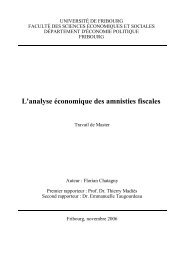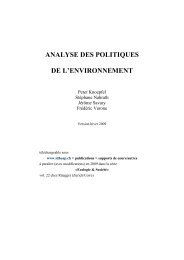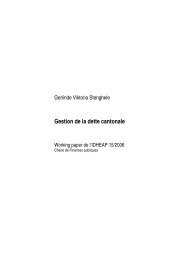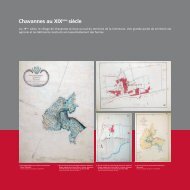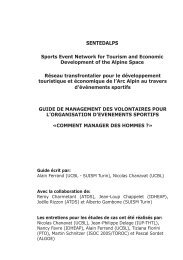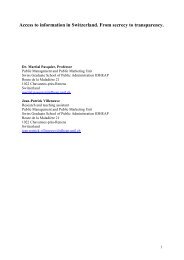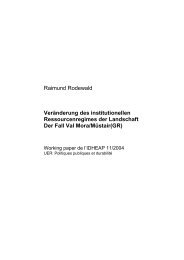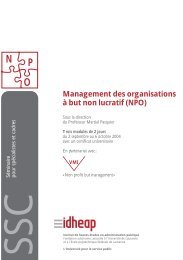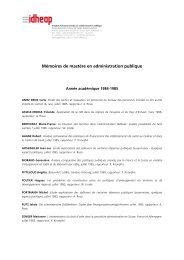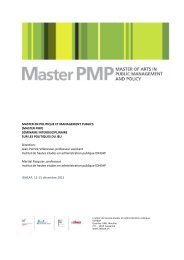Voting advice applications and party choice: evidence from ...
Voting advice applications and party choice: evidence from ...
Voting advice applications and party choice: evidence from ...
You also want an ePaper? Increase the reach of your titles
YUMPU automatically turns print PDFs into web optimized ePapers that Google loves.
<strong>Voting</strong> <strong>advice</strong> <strong>applications</strong> <strong>and</strong> <strong>party</strong> <strong>choice</strong> 381<br />
Table 6<br />
Party change between the 2003 <strong>and</strong> 2007 elections among those who were influenced<br />
in their vote decisions by smartvote<br />
Party voted<br />
for in 2003<br />
Party voted for in 2007<br />
CVP FDP SVP SP GPS GLP<br />
Total<br />
CVP<br />
FDP<br />
SVP<br />
SP<br />
GPS<br />
Total<br />
N 59 17 55 41 62 234<br />
% 25.2 7.3 23.5 17.5 26.5 100.0<br />
N 152 99 46 45 135 477<br />
% 31.9 20.8 9.6 9.4 28.3 100.0<br />
N 48 89 19 9 23 188<br />
% 25.5 47.3 10.1 4.8 12.2 100.0<br />
N 135 137 22 728 251 1273<br />
% 10.6 10.8 1.7 57.2 19.7 100.0<br />
N 28 16 6 178 117 345<br />
% 8.1 4.6 1.7 51.6 33.9 100.0<br />
N 363 301 144 298 823 588 2517<br />
% 14.4 12.0 5.7 11.8 32.7 23.4 100.0<br />
Source: NCCR “Democracy”, IP16 “smart-voting 2.0” (http://www.nccr-democracy.<br />
uzh.ch/research/module5/smart-voting/smart-voting).<br />
Notes: Only the major five parties in Switzerl<strong>and</strong> plus the Green-liberals are included<br />
in this table. CVP = Christian-democrats; FDP = Liberal-democrats; SVP =<br />
National-conservatives; SP = Social Democrats; GPS = Greens; GLP = Greenliberals.<br />
The Green-liberals is a new <strong>party</strong> <strong>and</strong> did not run in the 2003<br />
elections.<br />
With regard to the five major parties in Switzerl<strong>and</strong>, a remarkable number of smartvote<br />
users changed their vote to the Green-liberals, a newly founded <strong>party</strong> that ran for seats in<br />
a national election for the first time in 2007. In general, the percentage values indicate<br />
that the major flow of votes is restricted to parties with similar ideological positions. The<br />
largest movement of voters can be found between the Greens <strong>and</strong> the Social Democrats<br />
on the left side of the political spectrum <strong>and</strong> between the Liberals <strong>and</strong> the Nationalconservatives<br />
on the right side. The Christian-democrats, as the classic centre <strong>party</strong>, gains<br />
<strong>and</strong> loses voters to both sides. In contrast, the flows of voters between the parties on the<br />
poles are rather small.2<br />
If we look at the votes received <strong>and</strong> lost by the different parties due to smartvote<br />
users, we find on the winning side the Green-liberals (plus 588 votes) followed by the<br />
Greens (plus 478 votes) <strong>and</strong> the Christian-democrats (plus 129 votes). Among the losing<br />
parties are, first, the Social Democrats (minus 975 votes), followed by the Liberaldemocrats<br />
(minus 176 votes) <strong>and</strong> the National-conservatives (minus 44 votes). These<br />
findings should not be overrated due to the aforementioned problems of the data sample,<br />
but they indicate to some degree which <strong>party</strong> gained <strong>and</strong> which <strong>party</strong> lost votes through<br />
smartvote.



